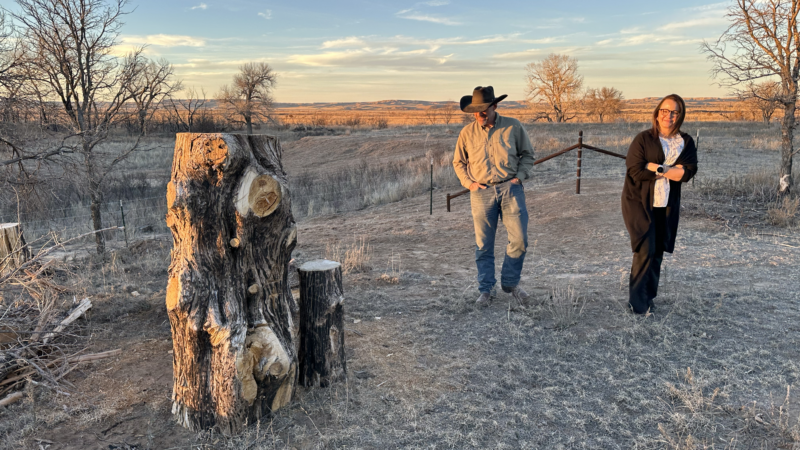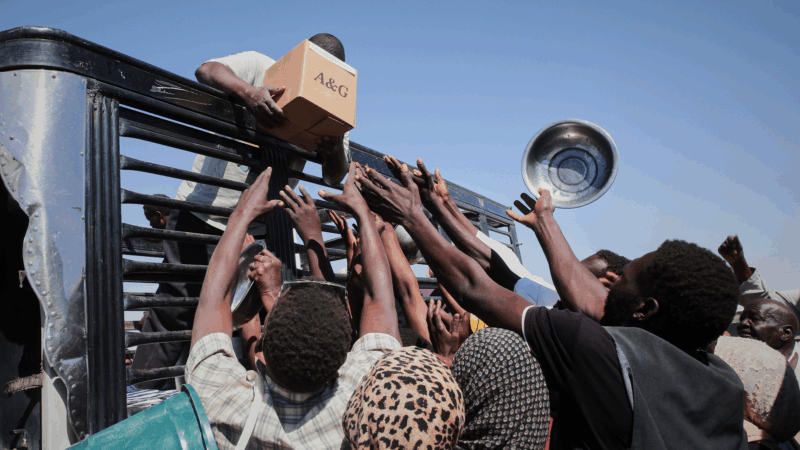‘Beauty from the ashes.’ Texas Panhandle recovering one year after the state’s largest wildfire
CANADIAN, TEXAS — As the longtime editor and publisher of The Canadian Record, Laurie Ezzell Brown had covered many wildfires in the drought-plagued Texas Panhandle. But nothing prepared her for what she saw after the Smokehouse Creek Fire last year.
“Everyone I know lost something,” Ezzell Brown told The Texas Newsroom, as she stood surrounded by the newspaper’s archives at its office downtown. The fire, she said, “had moved so quickly and done so much damage in so little time, it was shocking to see.”
The amount of earth it scorched, the high winds and how the fire jumped from place to place made this fire different, she said.
“The firefighters that I talked to said they’d never seen anything like it,” Ezzell Brown remembered.
The Smokehouse Creek Fire would eventually become the largest wildfire in Texas history, burning over a million acres. Two people were killed and hundreds of structures were destroyed, including 53 houses in Canadian. The fire started in late February and burned through mid-March.
A year later, residents of Canadian and the surrounding ranchlands are still picking up the pieces of their lives. They say a full recovery could take years.

A firsthand look at Smokehouse Creek fire recovery
Ezzell Brown has lived most of her life in Canadian. While The Canadian Record stopped publishing a print edition in 2023, Ezzell Brown still maintains the newspaper’s website and social media. In the fire’s immediate aftermath, she straddled the line between journalist and neighbor — documenting the losses of her friends and loved ones.
“I started going out and seeing what had burned and then talking to the homeowners who were picking up, you know, whatever remained of their lives,” Ezzell Brown said. “And there wasn’t much left.”
With a population of about 2,200, Canadian is one of dozens of idyllic-looking small towns dotting the Panhandle plains. It is situated just 30 minutes from the Oklahoma state line, surrounded by golden, rolling hills. Around town, most burned out homes and buildings have been leveled, but traces of the destruction linger.
The ranching industry, the economic anchor of the region, took a sizable hit. About 85% of Texas’ beef cattle come from the region. The Smokehouse Creek fire killed more than 15,000 head of cattle, an immense loss in a region where ranching isn’t just an industry, but a way of life.

This year, the majority of Texas is facing severe wildfire danger. Wildfires have sprung up across the state in recent weeks, fueled by high winds, dry conditions and warm weather. Texas is also plagued by drought ranging from “abnormally dry” to “extreme drought” according to the U.S. Drought Monitor.
Because of all this, Texas Gov. Greg Abbott issued a disaster declaration for the state in early March.
Recent studies are finding that climate change could be responsible for wildfires across the country, as was the case of recent wildfires in California.
Shane and Tatum Pennington, who manage Fields Ranch outside Canadian, saw the Smokehouse Creek Fire’s devastation firsthand. The couple has lived on the comparatively small, 8,000 acres ranch with their family for more than 20 years.
“It’s pretty good country when it rains,” Shane said from behind the wheel of his white pickup truck. “But after that fire, we didn’t get much rain.”
For months after the blaze, Shane’s fields were charred black. Now, some green is poking through. But amid ongoing drought conditions, yellow grass covers most of their pastures, leaving little grazing area for the herd.
Driving around the ranch, the Penningtons pointed to scars from the fire’s aftermath. Turning into a little pasture next to the Canadian River, Tatum’s mind returns to the day after the fire roared through the ranch.
“When we drove down here, we had no idea what we were fixing to see,” he said. “And everywhere you look, there (was) just dead, burnt cattle and calves.”
The Penningtons’ herd is now around 100 head of cattle, about a third of what it was before the fire. The couple have been in recovery mode ever since — burying cattle, ripping up the remains of 100-year-old cottonwood trees and replacing about 18 miles of fences.
One mile can cost between $15,000 and $20,000, Shane said.
“We’re thinking we’ve got, maybe another seven or eight miles,” he said. “And then we’ll be done.”

Claims, bills and relief efforts
Landowners across the Panhandle have also been tackling legal claims against Xcel Energy, which provides much of the region’s electricity. The fire was still burning last year when Xcel acknowledged one of their power lines started the fire. It is now facing several lawsuits.
Adrian Rodriguez, president of Xcel Energy – New Mexico and Texas, told The Texas Newsroom the company opened up an expedited process to resolve more than half of the 205 claims it’s received so far from landowners.
“We’re looking forward to a resolution on every single one of those cases,” Rodriguez said. “But we also note that we are in an area with extreme fire danger, with high winds and low humidity and plenty of dry fuels. And as an industry and as a company, we’re committed to hardening our system to address these extreme weather conditions.”
The Texas Legislature is also taking up a package of bills lawmakers say could help prevent fires like this in the future, as well as pump more money into the volunteer fire departments that make up much of the local firefighting resources in these rural areas.
The total economic impact of the Smokehouse Creek fire could ultimately exceed $1 billion, according to a report from a special legislative committee.
“Beauty from the ashes”
Despite the destruction, residents, businesses and civic leaders rallied to help neighbors who lost their homes and property. Financial contributions, donated supplies and volunteer labor flooded in during the months after the fire. Ezzell Brown said well-wishers sent cattle, hay and other supplies that could have filled up the county’s exhibition center 100 times over.
“It sounds weird, but as hard as it’s been, I wouldn’t change what we’ve been through. Because it’s just eye opening,” said Mallori Wilhelm, a mother of five and the wife of a farmer and rancher who lost her home. “Good has come from it.
“Beauty from the ashes. I mean truly.”

The Wilhelms are now settled in a new home in town. While a few families left Canadian after the fire, Hemphill County Judge Lisa Johnson told The Texas Newsroom that most stayed, “determined to heal their lives and land.”
The rebuilding process is something that has given the Penningtons hope.
“The renewal of it — I’m grateful that my kids are able to experience that,” said Tatum Pennington. “We all know how hard life is, and this won’t be the first time that they have to do this.”
But with drought conditions continuing, they still hold the fear of another wildfire.

“We’re awful dry right now,” Shane Pennington said. “If something sparked, we’d burn again.”
Transcript:
ARI SHAPIRO, HOST:
Wildfires have ignited across the country this year from Southern California to New York, and above-normal fire activity is anticipated for large parts of the country this month, including in much of Texas. This fire risk comes as residents of the Panhandle are marking one year since the largest wildfire in Texas history. It consumed over a million acres. And as the Texas Newsroom’s Rachel Osier Lindley reports, residents say recovery will take years.
RACHEL OSIER LINDLEY, BYLINE: Canadian is one of dozens of idyllic-looking small towns dotting the panhandle plains. Like everyone in this community of 2,200, Laurie Ezzell Brown has seen wildfires before but nothing like the Smokehouse Creek fire.
LAURIE EZZELL BROWN: Everybody I know, you know, lost something.
LINDLEY: Ezzell Brown is the editor and publisher of the Canadian Record newspaper. She’s lived here most of her life.
EZZELL BROWN: It had moved so quickly and done so much damage in so little time. It was shocking to see.
LINDLEY: Two people were killed. Businesses and homes were destroyed, including 53 houses in Canadian and more on the ranches surrounding the town. Over 15,000 head of cattle died in the fire.
EZZELL BROWN: Our economy is largely based on ranching, on cattle, so it’s a way of life.
LINDLEY: Around 85% of Texas’ beef cattle come from the region, which has experienced drought for years.
SHANE PENNINGTON: Seatbelt.
LINDLEY: Outside of town, Shane Pennington and his wife, Tatum, climb into their white pickup truck to survey the Fields Ranch.
S PENNINGTON: It’s a small place compared to a lot of them in this part of the world. It’s about 8,000 acres.
LINDLEY: The Penningtons managed the ranch, where their families lived for more than 20 years.
S PENNINGTON: In this little pasture we just pulled into, it’s right next to the Canadian River. This was actually – this little area here was where most of the dead cattle were that we found.
TATUM PENNINGTON: Like, when we drove down here, we had no idea what we were fixing to see. And, like, it’s hard to enter down here because it was so graphic and terrible. I mean, I don’t…
S PENNINGTON: Some of them were still alive…
T PENNINGTON: Yeah.
S PENNINGTON: …Couldn’t get up.
T PENNINGTON: Yeah.
S PENNINGTON: You know, and just…
T PENNINGTON: Falling – and everywhere you look, there’s just dead, burned cattle and calves.
LINDLEY: They say their herd’s small right now, just over 100 when it’s usually three times the size. Since the fire, the Penningtons have been in recovery mode, including replacing 18 miles of fences.
S PENNINGTON: It can cost anywhere from, I mean, 15,000 to 20,000 a mile. We’re thinking maybe we’ve got another probably 7 or 8 miles.
LINDLEY: The fire was still burning last year when Xcel Energy acknowledged one of their power lines started the fire. One year later, Xcel’s facing several lawsuits. A company representative told me it’s already resolved more than half of the claims it’s received from landowners and said Xcel’s making infrastructure improvements.
A report from the Texas legislature estimated the fire’s impact could ultimately exceed $1 billion. Now the state legislatures considering increasing funding for fighting wildfires. In some rural areas like this, the fire departments are run by volunteers. After the initial shock over the damage caused by the fire, Canadian transitioned into a massive relief effort.
EZZELL BROWN: And that went on for months.
LINDLEY: Laurie Ezzell Brown says, despite the devastation around Canadian, everyone’s pitched in to help, donating their time and supplies.
EZZELL BROWN: They filled up the county exhibition center, and they could have filled it up 100 more times.
LINDLEY: Mallori Wilhelm’s a mother of five and the wife of a rancher. The family’s rebuilding their lives in a new home after losing theirs in the fire.
MALLORI WILHELM: When you go through something like that, that’s when you see, wow, people are awesome and good has come from it – beauty from ashes, I mean, truly.
LINDLEY: While some residents have moved away, most of stayed in Canadian. People say it’ll take three, five, even 10 years for the region and ranching industry to recover. On the Fields Ranch, Shane Pennington says, while there may not be enough grass for his cattle right now, there is enough for another fire.
S PENNINGTON: We’re awful dry right now. You know, if something kicked off, sparked off, we would burn again.
LINDLEY: After all, as Tatum Pennington says, this is the windy season.
T PENNINGTON: March always has those 60 mile-per-hour, 70 mile-per-hour sustained wind days for some reason.
LINDLEY: Something she says puts everyone on edge after what they’ve been through – for NPR News, I’m Rachel Osier Lindley, in Canadian, Texas.
Light from satellites will ruin majority of some space telescope images, study says
Astronomers have long been concerned about reflections from satellites showing up in images taken by telescopes and other scientific instruments.
Defense Department is reviewing boat strike video for possible release, Hegseth says
In a speech on Saturday, Defense Secretary Pete Hegseth defended the strikes, saying: "President Trump can and will take decisive military action as he sees fit to defend our nation's interests."
Bama, Miami in, Notre Dame out and Indiana No. 1 in College Football Playoff rankings
Nobody paying attention for the past 24 months would be surprised to see Indiana – yes, Indiana – leading the way into this year's College Football Playoff.
McLaren’s Lando Norris wins first F1 title at season-ending Abu Dhabi Grand Prix
Red Bull driver and defending champion Max Verstappen won the race with Norris placing third, which allowed Norris to finish two points ahead of Verstappen in the season-long standings.
A ban on feeding pigeons ruffles lots of feathers in Mumbai
The pigeon population has exploded — a result of people feeding the birds. For some it's a holy duty and a way to connect to nature. Critics point to health risks tied to exposure to pigeon droppings.
UN humanitarian chief: world needs to ‘wake up’ and help stop violence in Sudan
The UN's top humanitarian and emergency relief official has told NPR that the lack of attention from world leaders to the war in Sudan is the "billion dollar question".








